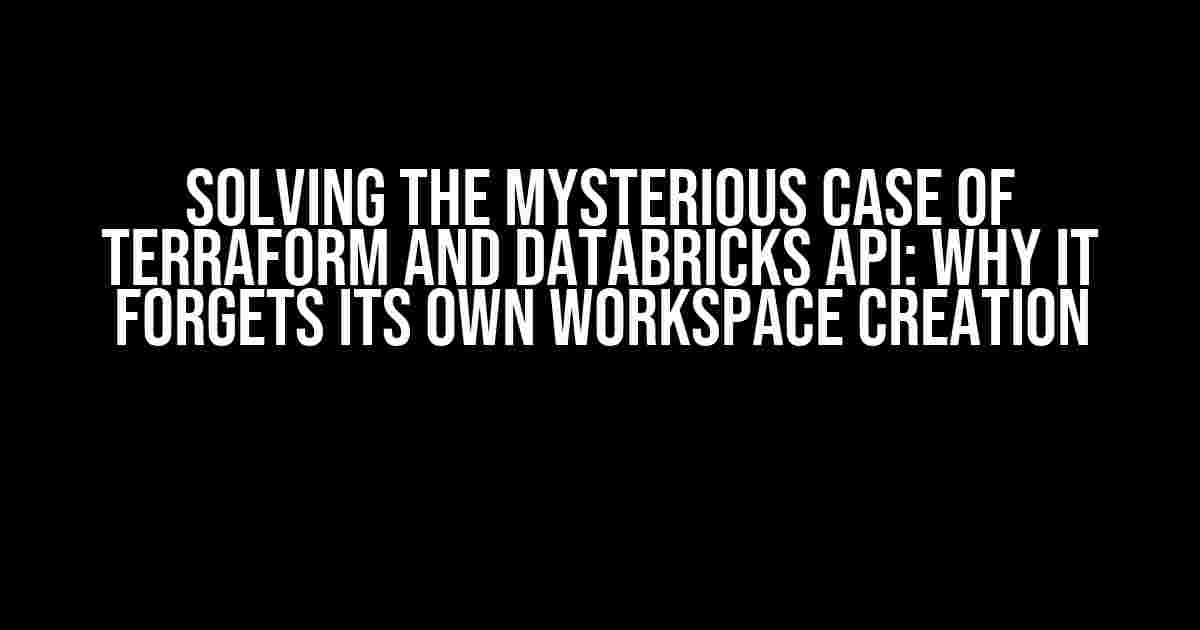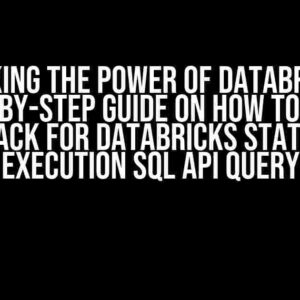Are you tired of scratching your head, wondering why Terraform and Databricks API seem to have a selective memory when it comes to creating new workspaces? You’re not alone! Many developers have faced this frustrating issue, where Terraform successfully creates a new workspace, but the Databricks API refuses to acknowledge its existence, demanding that you set a host property. In this article, we’ll delve into the root cause of this problem and provide a step-by-step guide to resolving it once and for all.
Understanding the Terraform and Databricks API Integration
Before we dive into the solution, let’s take a moment to understand the Terraform and Databricks API integration. Terraform is an infrastructure as code (IaC) tool that enables you to manage and provision cloud and on-premises resources. Databricks, on the other hand, is a unified analytics platform that provides a collaborative workspace for data engineers, data scientists, and data analysts to work together on data projects.
The Databricks API allows you to programmatically create, manage, and interact with Databricks resources, such as workspaces, clusters, and jobs. Terraform provides a Databricks provider that enables you to manage Databricks resources using Terraform configurations.
The Problem: Terraform Creates a Workspace, but Databricks API Forgets
When you use Terraform to create a new Databricks workspace, you might encounter an issue where the Databricks API doesn’t recognize the newly created workspace. This can lead to errors when trying to create clusters, jobs, or other resources within the workspace. The error message typically reads:
Error: Error creating Databricks cluster: Could not create cluster: The workspace with ID [workspace_id] does not exist.
The root cause of this issue lies in the way Terraform and Databricks API interact with each other. When Terraform creates a new workspace, it doesn’t automatically set the host property, which is required for the Databricks API to recognize the workspace.
The Solution: Setting the Host Property
To resolve this issue, you need to set the host property manually using the Databricks API. Here’s a step-by-step guide to help you do so:
-
First, create a new Databricks workspace using Terraform:
provider "databricks" { host = "https://dbc-1234567890123456789.azuredatabricks.net" } resource "databricks_workspace" "this" { name = "my_workspace" } -
Verify that the workspace has been successfully created by checking the Databricks web console or using the Databricks API:
curl -X GET \ https://dbc-1234567890123456789.azuredatabricks.net/api/2.0/workspace/get \ -H 'Authorization: Bearer YOUR_TOKEN' \ -H 'Content-Type: application/json' -
Retrieve the workspace ID from the response:
{ "workspace_id": "1234567890123456789", "name": "my_workspace", ... } -
Use the Databricks API to set the host property:
curl -X PATCH \ https://dbc-1234567890123456789.azuredatabricks.net/api/2.0/workspace/update \ -H 'Authorization: Bearer YOUR_TOKEN' \ -H 'Content-Type: application/json' \ -d '{"host": "https://dbc-1234567890123456789.azuredatabricks.net"}' -
Verify that the host property has been successfully set by checking the Databricks web console or using the Databricks API:
curl -X GET \ https://dbc-1234567890123456789.azuredatabricks.net/api/2.0/workspace/get \ -H 'Authorization: Bearer YOUR_TOKEN' \ -H 'Content-Type: application/json'
Why Does This Happen?
Terraform and Databricks API interact with each other using APIs, which can lead to asynchronous behavior. When Terraform creates a new workspace, it doesn’t automatically set the host property, which is required for the Databricks API to recognize the workspace. This is because the workspace creation process involves multiple steps, and the host property is set only after the workspace has been fully provisioned.
In the meantime, the Databricks API might attempt to access the workspace before the host property has been set, resulting in errors. By manually setting the host property using the Databricks API, you can ensure that the workspace is properly recognized and accessible.
Best Practices for Using Terraform with Databricks API
To avoid similar issues in the future, follow these best practices when using Terraform with Databricks API:
-
Use the latest version of the Databricks provider for Terraform.
-
Verify that the Databricks API token has the necessary permissions to create and manage workspaces.
-
Use the same API endpoint for both Terraform and Databricks API interactions.
-
Set the host property manually using the Databricks API after creating a new workspace.
-
Use Terraform’s built-in features, such as
depends_on, to ensure that resources are created in the correct order.
Conclusion
Terraform and Databricks API integration can be a powerful tool for managing and provisioning Databricks resources. However, it requires careful attention to detail to avoid common pitfalls like the one discussed in this article. By following the steps outlined above and adhering to best practices, you can ensure a seamless integration between Terraform and Databricks API.
If you’re still experiencing issues, don’t hesitate to reach out to the Databricks community or Terraform support for further assistance.
| Resource | Description |
|---|---|
| Terraform Databricks Provider | The official Terraform provider for Databricks. |
| Databricks API Documentation | The official documentation for the Databricks API. |
| Databricks Community Forum | A community-driven forum for discussing Databricks-related topics. |
Frequently Asked Question
Terraform and Databricks API can be a bit tricky, but don’t worry, we’ve got you covered! Here are some frequently asked questions to help you troubleshoot the common issue where Terraform and Databricks API don’t recognize a newly created workspace and require setting a host property.
Why does Terraform not recognize the newly created Databricks workspace?
This is likely due to a delay in the Databricks API propagating the new workspace creation. Terraform may have created the workspace, but the API hasn’t yet updated to reflect the change. Try adding a `depends_on` clause to your Terraform configuration to wait for the workspace creation to propagate.
What is the `depends_on` clause, and how do I use it?
The `depends_on` clause is a Terraform meta-argument that specifies explicit dependencies between resources. To use it, add a `depends_on` block to your workspace resource, specifying the ID of the resource that Terraform should wait for before creating the workspace. For example: `depends_on = [databricks_workspace.this.id]`.
How do I set the host property in Terraform for my Databricks workspace?
To set the host property in Terraform, you can use the `host` argument within your `databricks_workspace` resource. For example: `host = “https://dbc-123456789012.cloud.databricks.com”`. Make sure to replace the URL with your actual Databricks workspace URL.
Why do I need to set the host property, and what does it do?
The host property tells Terraform where to connect to your Databricks workspace. By setting it, you’re specifying the URL that Terraform will use to interact with your workspace. This is necessary because Terraform needs to know the exact URL to use when creating and managing resources within your workspace.
Will setting the host property fix the issue of Terraform not recognizing the newly created workspace?
Yes, setting the host property should fix the issue. By specifying the correct URL, Terraform will be able to connect to your newly created workspace and recognize it as an existing resource. This should resolve the issue of Terraform not recognizing the workspace.


